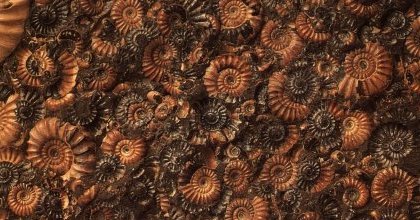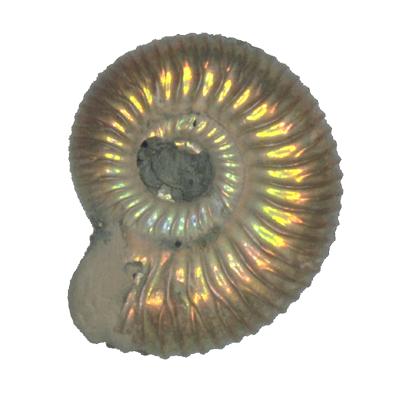

|

|
 |
Ammonites first appeared in the fossil record during the Ordovician Period and died out at the close of the Cretaceous Period, about sixty-five million years ago. Like the dinosaurs, they too fell prey to the mass extinction that occurred during this time period. The divisions between the chambers are called sutures. Sutures are studied to determine the age of the ammonite. The more intricate the suture patterns, the more highly evolved and the more recent the ammonite. |
| Ammonites provide important clues about the geologic age of deposits in which they are found. Ammonites have been prized for their beauty since biblical times. Here are some of the worlds most prolific ammonite deposits. |
 |
|
Morocco has vast deposits of Devonian Limestone which date back three hundred fifty million years. Ammonites found today in Morocco once flourished in a warm shallow sea which covered what is now the Sahara Desert. As the shells of the creatures accumulated on the sea floor, they were buried by sediments. Over the ages, they were transformed into stone by physical, and chemical processes. Today, they are quarried from marble, or calcium carbonate deposit. The stone is carved and polished by Moroccan craftsmen to reveal a rare glimpse of ancient life on earth and are often sold commercially. |
|
|
Great Britain is rich in fossil ammonites from the Jurassic Period. High and crumbling cliffs at Lyme Regis and Charmouth are formed of shale and beds of limestone. Ammonites of all sizes are common. Small ammonites preserved in pyrite occur in shales and are found loose on the beach. Near Whitby, there are beds of nodules which often contain ammonites. The Fradingham Ironstone is composed of lenses of the different ironstone laid one on top of another. The calcite replacement of the ammonites from this location is a striking contrast of white against a gray mudstone. |
|
|
A number of species of cretaceous ammonites are found in the Pierre and Bearpaw Shales of Montana and Fox Hills Sandstone of South Dakota. Some were quite large, up to 30 inches in diameter. Though it was once believed that they were a favorite food of the Mosasaurs, which frequently dined on this Cretaceous creature, and fossil records are now questioned about whether indentations in the shells of the ammonite were from Mosasaur. |
|
|
Cretaceous ammonites have extremely intricate suture patterns. They are often found with a colorful nacreous shell coating which reflects beautiful color flashes when coated with a clear lustrous resin. Some species flash bright red, green and lavender colors and are prized as a gemstone called "Ammolite". |
 |
| Other species have soft opal colors much like "mother of pearl". The intricate suture patterns are revealed when the nacreous shell coating is removed, so there is some consolation in finding an ammonite without this original coating. |
|
To see additional ammonite images that show a variety ammonite exteriors, just click on the icon below.
|
To a collection of ammonites from Texas, just click on the icon below, and take a peek.
|
 RETURN TO THE HISTORY HOUSE PALEONTOLOGY ROOM |
 RETURN TO THE HISTORY HOUSE HOME PAGE |
|
contact  The
History House. The
History House. |
|
|